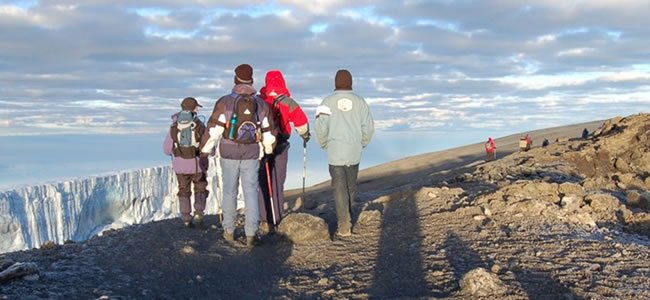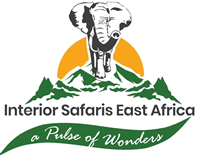
Interior Safaris EA will organize this Trek to Mount Kilimanjaro on the Rongai route, a Kilimanjaro trek through an old route can take from 6 / 7 Days round trip Kilimanjaro Climb Rongai Route with 86% of summit success rate, a Kilimanjaro hikes via rongai can start from northern which is a Tanzania and Kenya border side of Kilimanjaro
Day 1: Rongai Gate 1950 m to 1st Caves Camp 2600 m
 After an early breakfast at your hotel, you will be picked up from Arusha 1400 m and driven to the Marangu Gate (1980 m). At the gate, the porters will organize and pack the belongings for the hike while you and your guide register with the Tanzania National Park Tanapa. You will then be transferred by vehicle to the Rongai trail head, which is 2.5 hours away from the Managu Gate. The trail begins in the tall cornfields then leads into the pine forest. This trail has a gradual ascent and allows hikers to enjoy their surroundings. About halfway up the trail you will have a lunch break and you will reach the 1st Caves Camp (2600 m) in the late afternoon or early evening. The porters and chef, who move very fast up the mountain, will reach camp before you and set up your tents, boil drinking water, and prepare snacks for your arrival. After washing up, a hot dinner will be served. For overnight, mountain temperatures may drop to freezing so be prepared.
After an early breakfast at your hotel, you will be picked up from Arusha 1400 m and driven to the Marangu Gate (1980 m). At the gate, the porters will organize and pack the belongings for the hike while you and your guide register with the Tanzania National Park Tanapa. You will then be transferred by vehicle to the Rongai trail head, which is 2.5 hours away from the Managu Gate. The trail begins in the tall cornfields then leads into the pine forest. This trail has a gradual ascent and allows hikers to enjoy their surroundings. About halfway up the trail you will have a lunch break and you will reach the 1st Caves Camp (2600 m) in the late afternoon or early evening. The porters and chef, who move very fast up the mountain, will reach camp before you and set up your tents, boil drinking water, and prepare snacks for your arrival. After washing up, a hot dinner will be served. For overnight, mountain temperatures may drop to freezing so be prepared.
Day 2: Caves Camp 2600 m to Kikelewa Cave 3600 m
Following a hot breakfast, hikers will continue their ascent to Kikelewa Cave 3600 m. The trail passes Second Cave 3450 m and this is a good spot to take a lunch break. Similar to the first night, your tents will be set up prior to arriving at camp and the porters will prepare drinking and washing water for you. You will enjoy evening snacks then dinner prepared by our chef. Be prepared for a cold night as temperatures drop below freezing at this exposed camp.
Day 3: Kikelewa Cave 3600 to Mawenzi Tarn Camp 4330 m
On this day, hikers will enjoy a short, yet steep trail to Mawenzi Tarn Camp 4330 m. In the moorland, you will spot exotic plants, including giant lobelia and groundswell. At camp, hikers will enjoy spectacular views and allow their bodies to acclimate. Hot dinner and washing water will be prepared for hikers as they enjoy the magnificent sunset.
Day 4: Mawenzi Tarn Camp 4330 m to Kibo Hut 4700 m
After breakfast, hikers will continue ascending east for a half-day hike to Kibo Hut. Kibo is located in the “Saddle,” which refers to the area located between the peaks of Mawenzi and Kibo in an alpine desert. There is no water at this camp, but hikers can buy mineral water and soft drinks at the camp office. An early dinner will be served so hikers can rest before attempting the summit the same night. Your guide will brief you in detail on how to prepare for summit night.
Day 5: Summit Attempt
Your guide will wake you around 23:30 for tea and biscuits. You will then begin your summit attempt. The trail is rocky up to Hans Meyer Cave 5150 m. You continue your ascent to Gillman’s point 5689m. reaching this section is an impressive achievement as the trail is steep, rocky, and at high altitude. Gillman’s is located on the crater rim. From this point, you will usually experience a snow covered trail until you reach the summit, Uhuru Peak 5895 m. reaching the summit of Mt. Kilimanjaro is a lifetime accomplishment! You will be able to spend a short time on the summit taking photographs and drinking tea before the descent to Barafu begins. The hike down to Kibo Hut takes about 3 hours. At Kibo Hut, you will rest and enjoy a hot lunch in the sun. After eating, you will continue descending down to Horombo Hut 3720 m. You will have a dinner, wash, and rest soundly at the hut after a strenuous day.
Day 6: Horombo Hut 3720 m to Marangu Gate 1980 m
Following a well-deserved breakfast, your staff will have a big celebration full of dancing and singing. It is here on the mountain that you will present your tips to the guide, assistant guides, chefs, and porters. After celebrating, you will descend for 6 hours back to Marangu Gate 1980 m. The National Park requires all hikers to sign their names to receive certificates of completion. Hikers who reached Gillman’s Point (5681 m) receive green certificates and hikers who reached Uhuru Peak 5895 m receive gold certificates. After receiving certificates, you will drive back to Arusha for long overdue showers and more celebrations which will be the end of your Kilimanjaro Trek Rongai.
End of the tour
Guide price
Price includes:
|
Price does not include:
|
Why do we use guide prices?
The price for every safari depends on the number of people travelling, their ages, the time of year, whether or not international flights are included, the type of transport and accommodation used and the activities undertaken.
We calculate according to the specific dates of your booking because after we publish our itineraries some things may change. For example, hotels may increase their prices, the government may introduce new taxes or some discounts may become available. Unfortunately, we also have to pass on surcharges imposed on us by, for example, airlines when fuel prices or airport taxes are unexpectedly increased.
We would be happy to prepare a quotation, based on your requirements. We normally include most costs in the price so all you need to bring with you is ‘pocket money’ for items like drinks, tips and personal shopping e.g. souvenirs.
Insurance
AMREF flying doctors provide a medevac service in case of illness or injury during your safari. This costs $25pp for 31 days. We recommend this service and can include it in your package price.
Booking
Once you have selected one of our safari packages you need to send us a booking form. When we receive this we will check availability and inform you if any changes are necessary and issue an invoice for a 50% deposit plus the full cost of any tracking permits (in case of cancellation permit fees are non-refundable). Only once this payment is received can we guarantee availability and issue a booking confirmation. Full payment is required 70 days before travel.
Payments and cancellation
We charge in US dollars. Payment is by bank transfer into our Standard Chartered USD bank account in Uganda. You can also pay by credit card although there is a 5% administration charge. For those booking from within Uganda, cash payments are possible at our office.
When we book your safari, we have to pay non-refundable deposits on your behalf, for example to hotels. Therefore, we charge cancellation fees as follows:
30% of reservation costs if you cancel more than 50 days before your arrival date
100% of reservation costs if you cancel less than 50 days before your arrival date
We strongly recommend that you include cancellation cover in your travel insurance.
Disclaimer: We enter into an agreement with you in good faith but we sometimes encounter unexpected changes in local conditions which can affect your itinerary or price. These changes are beyond our control and we are not liable for them. While we endeavour to protect you against the effects of these changes, we reserve the right to amend the agreed itinerary and price in response to them. Such changes include but are not limited to weather conditions, road conditions, supplier price increases, fuel increases, government tax increases, supplier service changes e.g. cancellation of ferry services for river crossings or national park operations (track maintenance, animal translocations). We assure you that, we will always give you as much notice as possible of changes, suggest alternative plans and keep additional charges to a minimum.
Accommodation
To help us select the right accommodation for your safari (and in the absence of a complete national hotel classification system e.g. 1*–5*) we use four levels: high-end, mid-range, budget and backpackers. These terms can mean different things to different people but are helpful to an extent.
Air-conditioned rooms are not available in all hotels. Where AC is available, there is usually an extra charge.
Some locations have a limited choice of accommodation and so, to stay there, you must accept what is available. Where possible we prefer to work with responsible accommodation providers. This means hotels and lodges which are locally owned, employ local staff, support their community and protect the local environment.



Transport
As standard, we use a spacious 7-seater, 4×4 safari Land Cruiser, with pop-up roof, fridge and phone/camera charging facilities. This is the perfect safari vehicle.



Alternatively, we offer a slightly cheaper 7-seater, 4×4 safari van with a pop-up roof.



5-seater versions of both Land Cruisers and vans are also available.
For large group tours we use small buses called Coasters. These usually seat around 28 people, including 5 jump (fold-down) seats in the aisle. They do not have a boot/trunk so luggage is carried on the back seats which reduces the seating capacity. The overhead luggage shelves are small and can only accommodate small bags. Therefore, we recommend you do not over pack.
All vehicles include a driver/guide and fuel for your itinerary. Additional activities, not included in your itinerary, may incur an additional fuel charge. Our vehicles are comprehensively insured, in good mechanical condition and have seat belts fitted.
Please let us know if you have any special travel requirements. For example, if your group has disabled members we will do our best to accommodate your needs.

